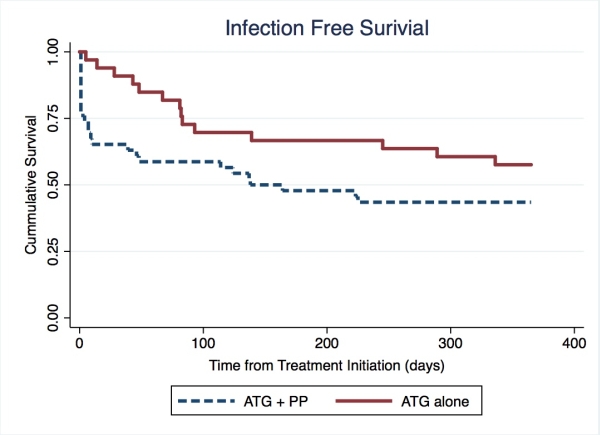Infectious Complications With Plasmapheresis in Combination With Antithymocyte Globulin Compared to Antithymocyte Globulin Alone in the Treatment of Acute Rejection
The Comprehensive Transplant Center, The Ohio State University Wexner Medical Center, Columbus, OH.
Meeting: 2015 American Transplant Congress
Abstract number: C78
Session Information
Session Name: Poster Session C: Infections Risks/Prevention and Immunosuppression
Session Type: Poster Session
Date: Monday, May 4, 2015
Session Time: 5:30pm-6:30pm
 Presentation Time: 5:30pm-6:30pm
Presentation Time: 5:30pm-6:30pm
Location: Exhibit Hall E
Background: Due to the complex nature of acute rejection (AR), multiple therapeutic modalities are necessary to prevent graft loss. The combination of prolonged cell depletion with ATG and antibody removal with plasmapheresis (PP) is concerning in regards to the risk of infection. The primary objective was to compare the incidence of infection in the first year following treatment initiation for AR among patients (pts) who received PP and ATG vs ATG alone.
Methods: This is a single-center, retrospective cohort study of kidney transplant recipients (KTR) treated for biopsy proven AR (antibody-mediated and/or cellular) between 1/2002 and 6/2013. Pts were included if they were a KTR between 19 and 70 years of age and were treated for AR with either PP and ATG during the same hospital admission or ATG alone. Pts could also be treated with steroids and/or IVIG. Pts were excluded if they received rituximab, eculizumab, OKT3, or bortezomib. Infection within 12 months was compared using the chi-square test. Time to infection was assessed using Kaplan-Meier and log-rank test.
Results: Seventy-nine pts were evaluated. There was no difference in infection rate during the 1 year study period (26/46 (56.5%) ATG+PP vs. 14/33 (42.4%) ATG alone, p=0.2). The types of infection identified were similar between groups. There was a trend towards a higher incidence of UTI, pneumonia, and bacteremia in the combination group. The median time to infection in the ATG and PP group was 7 days (range 0-225) and 81.5 days (5-336) for ATG alone (p=0.2). Review of the Kaplan-Meier estimate suggested ATG and PP might be associated with a higher risk in the first 60 days (19/46 (41.3%) ATG+PP vs. 5/33 (15%) ATG alone, p=0.01). 
Conclusion: The incidence of infection at 1 year was not different between groups. However, these results suggest pts treated for AR with the combination of ATG and PP were at increased risk of infection during the first 60 days following treatment.
To cite this abstract in AMA style:
Leino A, Hulbert A, Delahunty A, Rajab A, Visger JVon, Winters H. Infectious Complications With Plasmapheresis in Combination With Antithymocyte Globulin Compared to Antithymocyte Globulin Alone in the Treatment of Acute Rejection [abstract]. Am J Transplant. 2015; 15 (suppl 3). https://atcmeetingabstracts.com/abstract/infectious-complications-with-plasmapheresis-in-combination-with-antithymocyte-globulin-compared-to-antithymocyte-globulin-alone-in-the-treatment-of-acute-rejection/. Accessed December 15, 2025.« Back to 2015 American Transplant Congress
